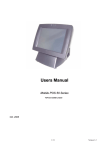Download details/user manual - SkillRex Technology
Transcript
Multi-Purpose Digital Optical Sensor User’s Manual About the User Guide The word ‘multi-purpose’ in the name itself signifies that Multi-Purpose Optical Sensors can be used for a number of purposes such as line sensing, obstacle sensing and light sensing. As a result, it is possible to build various robots for different applications using these sensors. PROPRIETARY NOTICE This document contains proprietary information furnished for evaluation purposes only; except with the express written permission of Skillrex Technology, such information may not be published, disclosed, or used for any other purpose. You acknowledge and agree that this document and all portions thereof, including, but not limited to, any copyright, trade secret and other intellectual property rights relating thereto, are and at all times shall remain the sole property Skillrex Technology and that title and full ownership rights in the information contained herein and all portions thereof are reserved to and at all times shall remain with Skillrex Technology. You acknowledge and agree that the information contained herein constitutes a valuable trade secret of Skillrex Technology. You agree to use utmost care in protecting the proprietary and confidential nature of the information contained herein. CONSTRUCTION: The sensors are very simple to understand and easy to implement. The major components of these sensors include a High glow Red LED and a Photodiode. The LED emits light when energized; hence acting like an optical transmitter. Whereas the photodiode is capable of detecting light incident on it, thereby acting like an optical receiver. Thus, these sensors work on the principle of light sensing. WORKING: The LED emits high intensity red light when current flows through it. If the emitted light of LED falls on any bright surface it is reflected back to the photo diode. Photo diode is a device which is able to detect the light intensity and convert it to a corresponding electric current. Other devices present in the board read the electric current generated from the photodiode and convert it to a logic voltage level which is either logic-0 or logic-1. Thus, depending on the presence or absence of the surface, logic data is developed by the light sensor APPLICATIONS: The MPOs can be used for a number of applications, some of which have been mentioned below: OBSTACLE SENSOR: In order to use this sensor as an Obstacle sensor mount the optical sensor on side of your robot facing them horizontally with the ground surface. Take care that your sensor is affected by any other bright light source which may affect the photodiode. Place any obstacle in front of your sensor (it is better if the obstacle is of white or any other light color). When your sensor detects the obstacle it will send a data of logic-0 through the data pin and when the obstacle is absent, it will send a data of logic-1 through the data pin. LINE SENSOR: In order to use this sensor as Line sensor, take a white chart paper and draw a black line on it (with water color preferably) or take a black chart paper and draw a white line on it. Place the sensor perpendicular to the ground level facing the ground and maintain a clearance of near about 1 to 2 centimeter between the sensor and the ground. When the sensor passes over a black surface it will send a data of logic-1 on data pin and when it passes over a white surface it will send a logic-0 on data pin. Thus, a sensor or two maybe able to follow a line while detecting any turn or curve along the line with a change in the logic data sent to the data pin. LIGHT SENSOR: This sensor can also be used to detect any other source of light. In order to use this sensor to detect a light source, it is required to cover the high glow red LED so that it may detect the light due to reflection. If light falls on it, it will send a data of logic-0 on data pin and when less light falls on it, it will sends a logic-1 on data pin. CONFIGURATION: In the Multi Purpose Optical Sensor, a 3-pin male connector or a berg strip is present. The three pins of this berg strip are D (Data), + (positive 5 V supply), - (ground). Supply to the sensor is provided by the logic supply that may be present on the mother board. In order to connect this sensor to the mother board you need a 3-band connector cable. Connect one side of the connector cable to the sensor, check the convention of D, + and -, and then connect the other side of the sensor cable to the motherboard by following the same convention of D, + and -. (IMPORTANT NOTE - While connecting the sensors, never do mistake of connecting with a wrong convention of D, + and – mentioned on motherboard and sensor.) For further details contact us: Website: -www.skillrextechnology.com Email: - [email protected] OR [email protected]








